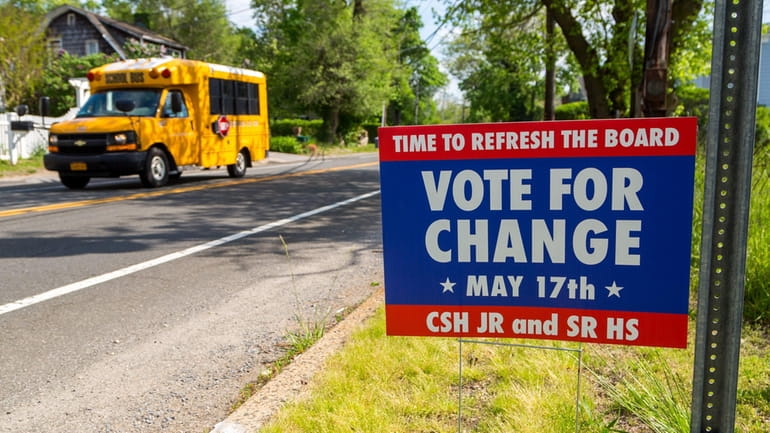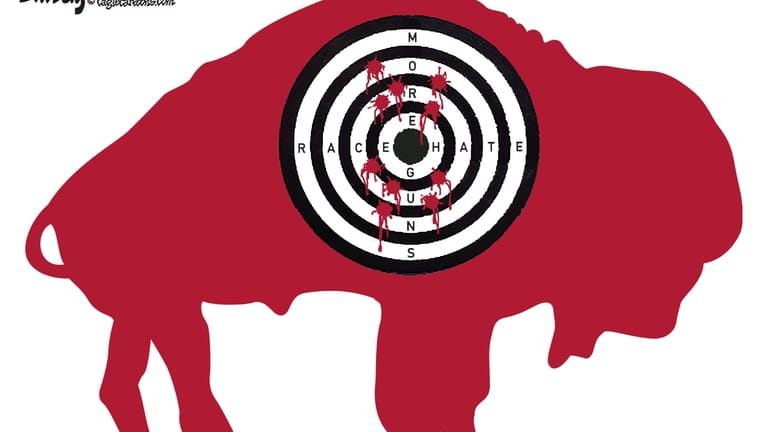School elections: Politics trump pocketbook issues

A school board election sign in Cold Spring Harbor Monday. Credit: Barry Sloan
Daily Point
School board races could be harbingers of the political mood
School board elections are today, but seats, not budgets, are the big story.
Parent activism that germinated around the pandemic is still focused on those issues, particularly as talk of renewed mask mandates in response to quickly rising infection numbers brews. But there are other reasons for the energy and sometimes rancor involving the elections: How discussions in schools around gender, sexuality, race and history ought to be conducted is chief among them. The buzzwords of “parental choice” and “transparency” are everywhere. So are accusations that children are being “groomed” to be gay or trans, or taught to hate themselves for their whiteness. And lists of candidates supported by teachers unions are being distributed so people know “who to vote against.”
Here are the districts and players to watch as the returns arrive.
- In Smithtown, Mike Simonelli, who lost a bid for Suffolk County Legislature running on the Conservative line last year, is in a battle with the Smithtown School District over what he calls “fantasy pronouns.” Simonelli has spoken at school board meetings on the issue of pronouns like “they/them” applied to students who prefer them, and on his Facebook page argued, “It is not an opinion to call the pronouns displayed on the 'Under the Umbrella: Gender & Sexuality' at Smithtown HS East as being grammatically and biologically incorrect.”
There are two candidates seeking seats that have received significant support from Long Island Loud Majority, a highly conservative online and in-person political advocacy group. - LILM has devoted tremendous energy to the race, campaigning for Kings Park candidates at the train station, showcasing candidates from Connetquot, Longwood, West Babylon, Plainedge, Smithtown, and other districts on their thrice-weekly podcasts. How those candidates do will go a long way to showing just how much power LILM can muster.
- A Facebook post on Moms for Liberty-Suffolk in support of newcomer candidates in Sayville demands “Vote as if the BOE is going to mask our kids again! Who would you want when it came down to that!”
- In Manhasset, residents received a text from an anonymous phone number Monday evening saying every Republican needed to vote for two candidates “to stop CRT from coming into classrooms & stop the watering down of standards. Progressives have declared war on our kids and every Republican to vote is needed to stop them.”
- The chairwoman of Moms for Liberty-Suffolk posted this Tuesday: “BOE ELECTIONS TODAY….Candidates across New York are running to protect PARENTAL RIGHTS in our childrens education. Taking on the incumbents who failed our children when we needed them most. Stood up to the corrupt establishment and well-funded unions. All that is remaining is YOUR VOTE. We can do this NY.”
- In the South Country race, a confrontation over the allegedly erratic driving of one school board candidate led to a minor traffic accident. Then a verbal confrontation led to a videotaped slap of the other driver involved in the accident, by another school board candidate who’d arrived at the scene.
- The Suffolk County Police Benevolent Association has endorsed in school board races for the first time, supporting candidates in Connetquot, Smithtown, Kings Park, Island Trees, Eastport-South Manor, Mount Sinai, Miller Place, Sachem and Brentwood, who they say will support teaching respect for law enforcement, and will support placing cops in schools.
- On the other side of the school-politics spectrum there is the Long Island Strong Schools Alliance, founded last June, which is endorsing establishment candidates, according to its founder, Miller Place’s Amanda Cohen-Stein, “in response to radicals and extremists who are attacking our school districts.” The group is supporting candidates in about 40 districts, nearly all of them also the choice of district teacher unions, and has formed a PAC.
And, of course, the New York State United Teachers, through its district chapters, is working overtime to elect the candidates they support. In Three Villages, Smithtown, and Sachem, for example, where strife in meetings has been extreme, local teachers associations are pushing hard to get out the vote for their candidates.
The union’s involvement, though, is the politicking surrounding these races that is both traditional and expected. What’s unusual, this year, is board races and curricula, rather than budget votes, getting the lion's share of their efforts.
— Lane Filler @lanefiller and Randi F. Marshall @RandiMarshall
Pencil Point
Race hate and more guns

Credit: FloridaPolitics.com/Bill Day
For more cartoons, visit www.newsday.com/nationalcartoons
Final Point
Why NY’s death penalty died
Reacting to a racist massacre driven by far-right ideology, state Republicans are pulling an old-time rallying cry for the death penalty out of the political attic.
“NY must bring back the death penalty!” Rep. Lee Zeldin, candidate for governor, tweeted on Monday, two days after 10 people were killed in Buffalo. “I’m calling on [Gov. Kathy] Hochul to act. We won’t let this go. Killing police officers & first responders, fatal hate crimes like yesterday’s attack in Buffalo, homicides w/ multiple victims, & many other crimes should be eligible for the death penalty.”
Andrew Giuliani, one of Zeldin’s rivals in the June 28 GOP primary, tweeted that the death penalty “should be on the table” for the Buffalo massacre. “I will push to make sure that is an option for mass murderers and cop killers!”
The aim of the campaign messaging is obvious enough. It seeks to turn the subject of an attack targeting Blacks in a Buffalo supermarket to something other than talk of gun laws, mental health, hate, and the internet.
It also provides a rhetorical deflection from purported “replacement” conspiracies expounded by suspect Payton Gendron and Zeldin’s congressional ally, Rep. Elise Stefanik.
What’s way more elusive is what would really happen if Zeldin, Giuliani or any other death-penalty advocate becomes governor.
Past may be prologue: GOP Gov. George Pataki vowed to put capital punishment back on the books in New York when he first ran in 1994. Once elected, he was able to make good on his promise. But circumstances then were far more favorable.
At that point murders and other violent crime had been hideously rampant — and for many years. A majority of both state legislative houses in Albany would annually approve a death penalty bill only to have it vetoed by Democratic governors Hugh Carey and Mario Cuomo.
Overrides require two-thirds approval from both houses, so those vetoes stood. When Pataki took office in 1995, all he had to do was sign the measure enacted by a long-ready legislative majority. Now, there is no such majority. With the death penalty no longer marketable as much of a crime solution, its chances seem highly unlikely.
Some of the death penalty’s demise as a proposed solution stems from practical experience. Nobody was executed in all of Pataki’s 12 years in office — a period during which violent crime fell dramatically all over the U.S. anyway, including in states that didn’t have capital punishment.
During Pataki’s final term, in 2004, the Court of Appeals ruled the 1995 law unconstitutional in a 4-3 vote.
The rhetoric was mostly the same a half-century ago. In 1978, after Carey issued a death-penalty veto, Assembly GOP Minority Leader Perry B. Duryea Jr. of Montauk claimed that the governor — against whom he would unsuccessfully run that November — “has denied New Yorkers the means they have asked for to protect themselves against savagery and terror.”
— Dan Janison @Danjanison
